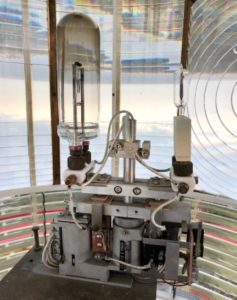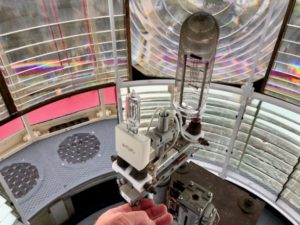Did you know that the Lighthouse can change its own lightbulb? Well, it can and has been doing so for many years now. In 1936, electricity was first brought to the Lighthouse. This meant significant changes for the Lighthouse keepers since they no longer had to carry buckets of kerosene to the top of the lighthouse to burn in the lamp to create the light. Now light bulbs did the work of producing the light! But the keepers still had to stay up all night to make certain that the light bulb didn’t burn out, and that if it did, they were there to replace it.

Carlisle & Finch Lamp Changer in place in the Lighthouse lens room.
Years later, an innovative company in Cincinnati, Ohio came up with an answer to help make life easier for lighthouse keepers – a lamp changer for lighthouses! The Carlisle & Finch Company, the “Global Leader in Spotlight Technology,” specializes in the production of high quality optical products for a range of maritime uses, including within the United States Coast Guard and Navy.
Our lamp changer holds two, 1000-watt bulbs. The one in the center, or primary position (the large bulb on the left), is the operational bulb. The one to the right is in the backup position. If the primary bulb burns out, the electrical circuit is broken, releasing a switch. A spring at the base of the bulb’s housing piece then rotates the backup bulb to the primary position, where it snaps into place and completes the circuit. The backup bulb comes on automatically.

Here, I am holding the lamp (bulb) in the halfway position.
Did you notice that the bulbs look very different? The larger bulb is an historic 1000-watt GE bulb that is no longer made. The smaller bulb is the replacement that GE came out with a few years ago; it is also a 1000-watt bulb. The smaller bulb sits upon a ceramic block that serves two purposes: it dissipates heat so that the bulb lasts longer, and it places the filament at the same height as the older bulbs so that the focal plane of the light shines correctly through the lens. The old bulbs are so old (some dating to WWII) that we don’t know how long they will last, so we always put a new bulb in the backup position. If we used two old bulbs, they might both burn out on the same night, which as St. Augustine’s navigation beacon, would become a crisis situation. We only have a certain number of the old bulbs left, and once they are gone, it will be the end of an era. Our Lighthouse will then have two of the new bulbs in place, and thankfully, if the bulb changer ever wears out, the Carlisle & Finch Company is still in business to help us replace it.
Contributed by Director of Museum Services Rick Cain, edited by Student Intern Jayda Barnes

